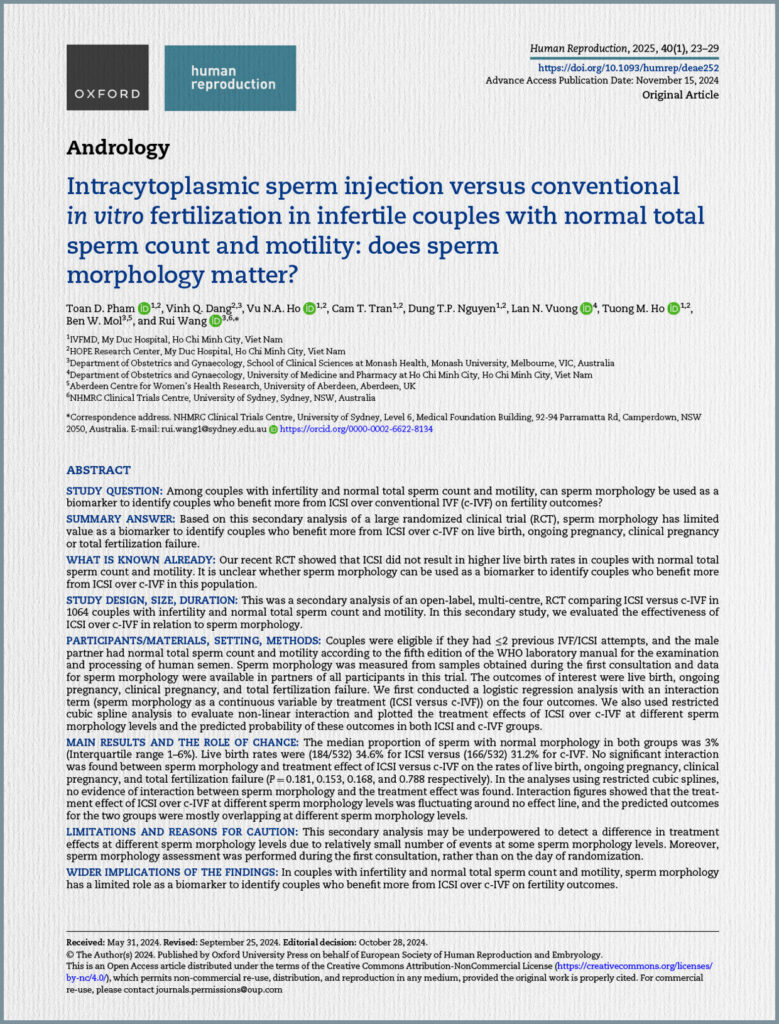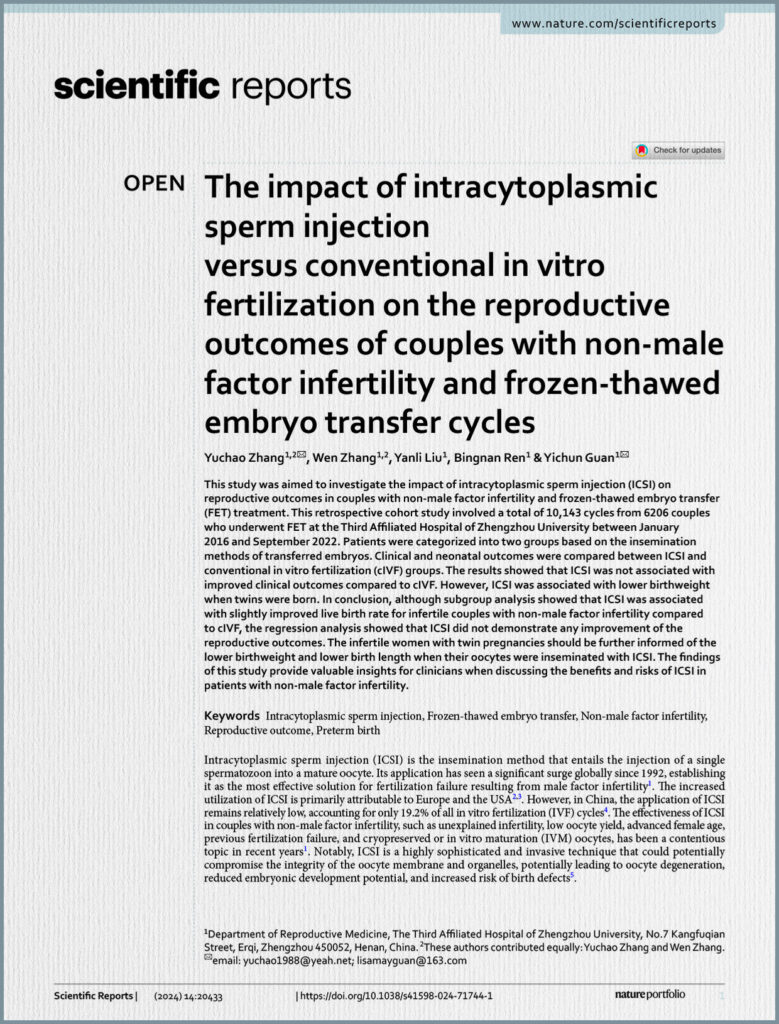This synthesis discusses the impact of intracytoplasmic sperm injection (ICSI) compared to conventional in vitro fertilization (cIVF) on the reproductive outcomes of couples with non-male factor infertility, particularly focusing on frozen-thawed embryo transfer (FET) cycles, and incorporates findings on sperm parameters and neonatal outcomes from other related sources.
Introduction and Background
Intracytoplasmic sperm injection (ICSI) is an assisted reproductive technology (ART) that involves the injection of a single spermatozoon into a mature oocyte. It was first successfully reported in humans in 1992, and since then, its use has dramatically increased globally. ICSI was initially introduced as the most effective solution for severe male infertility. However, its utilization has surged far beyond severe male factor cases, with a substantial increase observed specifically in couples diagnosed with non-male factor infertility. For example, in the US, ICSI use in non-male factor infertility cases rose from 15.4% in 1996 to 66.9% in 2012. Data from the Latin American Registry showed ICSI being used in four out of five cycles for couples without male factor infertility. While its application is widespread in some regions, its use remains relatively low in China compared to Europe and the USA.
Despite its success in addressing male infertility, the application of ICSI in couples with non-male factor infertility has been a subject of considerable debate. The rationale often cited for using ICSI in these cases includes preventing total fertilization failure (TFF) and increasing fertilization rates (FR). However, ICSI is a sophisticated and invasive technique that carries potential risks, such as damage to the oocyte membrane or organelles, which could lead to reduced embryonic development potential and potentially increase the risk of birth defects.
Numerous studies have investigated the efficacy of ICSI in non-male factor infertility, often yielding conflicting results. Much of the existing evidence comes from studies on fresh embryo transfer cycles following ovarian stimulation. There has been limited evidence regarding ICSI’s impact on reproductive outcomes specifically in couples with non-male factor infertility undergoing frozen-thawed embryo transfer (FET) treatment. The study by Zhang et al. titled “The impact of intracytoplasmic sperm injection versus conventional in vitro fertilization on the reproductive outcomes of couples with non‑male factor infertility and frozen‑thawed embryo transfer cycles” aims to address this gap by focusing on FET cycles.
Findings from the Zhang et al. Study (Focus on FET)
The study by Zhang et al. was a retrospective cohort study involving 10,143 FET cycles from 6206 couples with non-male factor infertility at the Third Affiliated Hospital of Zhengzhou University between 2016 and 2022. Patients were categorized into two groups based on whether the transferred embryos were conceived via ICSI or cIVF. The study compared clinical and neonatal outcomes between these groups.
The main findings indicated that ICSI was not associated with improved clinical outcomes compared to cIVF in couples with non-male factor infertility undergoing FET. While a subgroup analysis in this study showed a slight improvement in live birth rate with ICSI for this population, the overall regression analysis did not demonstrate any general improvement in reproductive outcomes.
Regarding neonatal outcomes, when considering single live births, the results were consistent with previous randomized controlled trials (RCTs). However, a notable finding specific to this study was that ICSI was associated with lower birthweight and shorter birth length when twins were born. Consequently, ICSI was linked to a higher low-birth-weight rate in twin pregnancies. The authors concluded that infertile women with twin pregnancies should be informed of the potential for lower birthweight and length if their oocytes were inseminated with ICSI.
The study acknowledged limitations, including its retrospective design which could introduce selection bias (though propensity score matching was used to mitigate this). The specific causes of non-male factor infertility were not detailed, which means the results apply to a broader population but limit subgroup analysis based on specific female factors. The study focused on primary clinical outcomes (pregnancy, miscarriage, live birth) and did not compare early reproductive outcomes like embryo quality or fertilization rate in detail within the FET context. Long-term follow-up of children was also not conducted.
Broader Evidence on ICSI in Non-Male Factor Infertility (Drawing from other sources)
Other sources provide broader perspectives on ICSI in non-male factor infertility, often based on fresh embryo transfer cycles.
A systematic review and meta-analysis by Yang et al. included 18 RCTs comparing ICSI and IVF in women with non-male factor infertility. This comprehensive review aimed to provide updated evidence due to conflicting results in previous reviews and the availability of new RCTs. It included studies randomizing either patients or sibling oocytes.
The Yang et al. meta-analysis found that ICSI did not improve Live Birth Rate (LBR) compared to IVF. They also found no significant difference in Clinical Pregnancy Rate (CPR) or Miscarriage Rate (MR). While ICSI was shown to reduce the risk of TFF and increase FR per oocyte inseminated/injected overall, the review noted that the apparent reduction in TFF was not evident when only studies randomizing patients (rather than sibling oocytes) were analyzed. The difference in fertilization rate calculations (per oocyte retrieved vs. per oocyte inseminated/injected) was explained by the fact that ICSI only injects mature oocytes, whereas cIVF exposes both mature and some immature oocytes to sperm, with some immature oocytes maturing in vitro during the process. This means that while ICSI might show a higher fertilization rate among the selected, injected oocytes, the overall rate among all retrieved oocytes might not differ significantly. The authors also calculated that it would require approximately 50 additional ICSI cycles to avoid one instance of TFF compared to IVF, arguing against routine use of ICSI solely for TFF reduction.
The “Key message” from the Yang et al. meta-analysis explicitly states that ICSI is not associated with lower fertilization failure and other reproductive outcomes in patients with non-male factor infertility. It concludes that, considering the cost and safety of ICSI, there is no evidence to support its routine use in these populations. This aligns with previous well-designed RCTs cited elsewhere, which also showed that ICSI did not improve LBR or clinical outcomes in couples with non-severe male factor infertility after adjusting for confounding factors.
The debate continues in specific subgroups, such as women of advanced maternal age or those with poor ovarian response. While some studies suggested ICSI might improve outcomes in these groups (e.g., higher FR and more top-quality embryos in advanced age in one small study), others showed comparable or even reduced LBR with ICSI. The Zhang et al. study, in its subgroup analysis based on female age and oocyte number (as a proxy for ovarian response), found no improved outcomes with ICSI.
Sperm Parameters and Predictive Value
Another relevant source explored whether sperm parameters can predict ART success. While various sperm parameters, such as progressive motility and morphology, are assessed, their ability to predict outcomes and guide the choice between ICSI and IVF, especially in cases without severe male factor infertility, appears limited.
A secondary analysis of a large RCT by Pham et al., specifically examining couples with infertility and normal total sperm count and motility, investigated whether sperm morphology could serve as a biomarker to identify those who would benefit more from ICSI over cIVF. Using WHO 2010 criteria for morphology assessment, the study concluded that sperm morphology had limited value as a biomarker for predicting improvements in live birth, ongoing pregnancy, clinical pregnancy, or TFF when choosing ICSI over cIVF in this population. This supports the finding from the Yang et al. meta-analysis that ICSI does not significantly reduce TFF when considering patient-level randomization, even across different levels of sperm morphology in the Pham et al. study [108, Figure 2A].
Sperm DNA fragmentation (sDNAfrag) is another parameter discussed. Some evidence suggests that higher sDNAfrag might negatively impact outcomes in IVF more than in ICSI, possibly due to the oocyte’s DNA repair capacity. However, the Pham et al. study did not evaluate sDNAfrag, and the overall predictive value of sDNAfrag is still debated, with no universally agreed-upon threshold for defining unsuccessful pregnancy.
Neonatal Health and Long-Term Outcomes
Concerns about the potential impact of ICSI on the health and development of ICSI-born children have been raised since the technique’s introduction. The Zhang et al. study’s finding of lower birthweight and length specifically in twin pregnancies conceived via ICSI is a significant result in the context of FET.
The broader literature presents conflicting reports on the prognosis of ICSI-born children. Some studies have reported that ICSI-born children show no significant differences in outcomes such as premature birth rate, newborn weight (though Zhang et al. found differences in twins), major malformations, chromosomal abnormalities, or psychological/motor/intellectual development compared to naturally conceived or IVF-conceived children at various ages up to 8 years. However, debates about the health and development of these children are ongoing, with some studies reporting positive results and others expressing concerns. The necessity for more multi-center, multi-regional, and multi-national long-term follow-up investigations is emphasized to accurately assess potential risks. The Yang et al. meta-analysis was limited in its ability to analyze congenital disabilities and neonatal growth due to a lack of sufficient data in the included RCTs.
Limitations and Future Research
The sources collectively highlight the complexity and ongoing questions surrounding ICSI use in non-male factor infertility. Limitations across studies include:
- Retrospective designs in some studies.
- Potential underpowering for analyzing less common outcomes or subgroups.
- Variations in study protocols and participant characteristics contributing to heterogeneity in meta-analyses.
- Lack of detailed information on specific female infertility etiologies in some studies.
- Limited data on early reproductive outcomes (like embryo quality) and long-term follow-up of children.
- Insufficient data specifically on FET cycles in systematic reviews focusing on non-male factor infertility.
Future research recommendations include conducting high-quality RCTs with large sample sizes to confirm findings. More attention is needed on the cost-effectiveness of ICSI. Long-term follow-up studies of children conceived via ICSI in various infertility scenarios are crucial for assessing health and developmental outcomes. Research specifically investigating the impact of ICSI on reproductive and neonatal outcomes in different types of female factor infertility, especially within FET cycles, is also needed.
Conclusion and Clinical Implications
Based on the evidence from these sources, including a large retrospective study focused on FET cycles, a systematic review and meta-analysis of RCTs, and analyses of sperm parameters, there is a general consensus that routine use of ICSI is not supported for couples with non-male factor infertility. ICSI does not appear to improve live birth rates or overall clinical outcomes in this population. While ICSI might affect fertilization rates per injected oocyte or show a trend toward reducing TFF in some study designs, these benefits do not translate into improved live birth rates. Considering the higher cost and invasiveness of ICSI compared to cIVF, and the lack of clear benefit in clinical outcomes for non-male factor infertility, it is generally recommended to avoid its routine use.











